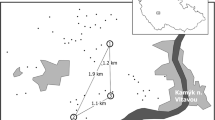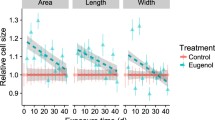Abstract
It is often assumed that host specialization is promoted by trade-offs in the performance of parasites on different host species, but experimental evidence for such trade-offs is scant. We studied differences in performance among strains of the anther smut fungus Ustilago violacea from two closely related host plant species, Silene alba and S. dioica, on progeny of (1) the host species from which they originated, (2) the alternative host species, and (3) inter-specific hybrids. Significant intra-specific variation in the pathogen was found for both infection success on a range of host genotypes (virulence) and components of spore production per infected host (aggressiveness) (sensu Burdon 1987). Strains did not have overall higher virulence on conspecifics of their host of origin than on strains from the heterospecific host, but they did have a significantly (c. 3 times) higher spore production per infected male host. This finding suggests that host adaptation may have evolved with respect to aggressiveness rather than virulence. The higher aggressiveness of strains on conspecifics of their host of origin resulted both from higher spore production per infected flower (spores are produced in the anthers), and greater ability to stimulate flower production on infected hosts. The latter indicates the presence of adaptive intraspecific variation in the ability of host manipulation. As transmission of the fungus is mediated by insects that are both pollinators of the host and vectors of the disease, we also assessed the effect of strains on host floral traits. Infection resulted in a reduction of inflorescence height, flower size, and nectar production per flower. Strains did not differ in their effect on nectar production, but infection with strains from S. alba resulted in a stronger reduction of inflorescence height and petal size on both host species. Vectors may therefore in principle discriminate among hosts infected by different strains and affect their efficiency of transmission. Contrary to assumptions of recent hypotheses about the role of host hybrids in the evolution of parasites, hybrids were not generally more susceptible than parental hosts. It is therefore unlikely that the rate of evolution of the pathogen on the parental species is slowed down by selection for specialization on the hybrids.
Similar content being viewed by others
References
Alexander HM (1989) An experimental field study of anther-smut disease of Silene alba caused by Ustilago violacea: genotypic variation and disease incidence. Evolution 43: 835–847
Alexander HM, Antonovics J (1988) Disease spread and population dynamics of anther smut infection of Silene alba caused by Ustilago violacea. J Ecol 76: 91–104
Alexander HM, Maltby A (1990) Anther-smut infection of Silene alba caused by Ustilago violacea: factors determining fungal reproduction. Oecologia 84: 249–253
Alexander HM, Antonovics J, Kelly AW (1993) Genotypic variation in plant disease resistance—physiological resistance in relation to field disease transmission. J Ecol 81: 325–333
Antonovics J, Alexander HM (1992) Epidemiology of anther-smut infection of Silene alba (=S. latifolia) caused by Ustilago violacea: patterns of spore deposition in experimental populations. Proc R Soc Lond B 250: 157–163
Baker HG (1947) Melandrium album and M. dioicum in the Biological Flora of the British Isles. J Ecol 35: 471
Baker HG (1951) The inheritance of certain characters in crosses between Melandrium dioicum and M. album. Genetica 25: 126–156
Biere A, Antonovics J (1996) Sex-specific costs of resistance to the fungal pathogen Ustilago violacea in Silene alba. Evolution (in press)
Boecklen WJ, Spellenberg R (1990) Structure of herbivore communities in two oak (Quercus spp.) hybrid zones. Oecologia 85: 92–100
Brasier CM (1987) The dynamics of fungal speciation. In: Rayner ADM, Brasier CM, Moore D (eds) Evolutionary biology of the fungi. Cambridge University Press, Cambridge, pp 231–260
Burdon JJ (1987) Diseases and plant population biology. Cambridge University Press, Cambridge
Burdon JJ, Jarosz AM (1991) Host-pathogen interactions in natural populations of Linum marginale and Melampsora lini. I: Patterns of resistance and racial variation in a large host population. Evolution 45: 205–217
Burdon JJ, Brown AHD, Jarosz AM (1990) The spatial scale of genetic interactions in host-pathogen coevolved systems. In: Burdon JJ, Leather SR (eds) Pests pathogens and plant communities. Blackwell, Oxford, pp 233–247
Castle AJ, Day AW (1984) Isolation and identification of α-tocopherol as an inducer of the parasitic phase of Ustilago violacea. Phytopathology 74: 1194–1200
Day AW, Jones JK (1968) The production and characteristics of diploids in Ustilago violacea. Gen Res 11: 63–81
Day AW, Castle AJ, Cummins JE (1981) Regulation of parasitic development of the smut fungus, Ustilago violacea, by extracts from host plants. Bot Gaz 142: 135–146
De Nooij MP, Van Damme JMM (1988) Variation in pathogenicity among and within populations of the fungus Phomopsis subordinaria infecting Plantago lanceolata. Evolution 42: 1166–1171
Dean HL (1959) Variations in style number and other gynoecial structures in Lychnis alba. Science 130: 42–43
Deml G, Oberwinkel F (1982) Studies in Heterobasidiomycetes, part 24. On Ustilago violacea (Pers.) Rouss. from Saponaria officinalis. Phytopathol Z 104: 345–356
Ennos RA, Swales KW (1991) Genetic variation in a fungal pathogen: response to host defensive chemicals. Evolution 45: 190–204
Ericson L, Burdon JJ, Wennström A (1993) Inter-specific host hybrids and phalacrid beetles implicated in the local survival of smut pathogens. Oikos 68: 393–400
Floate KD, Whitham TG (1993) The “hybrid bridge” hypothesis: host shifting via plant hybrid swarms. Am Nat 141: 651–662
Fritz RS, Nichols-Orians CM, Brunsfeld SJ (1994) Interspecific hybridization of plants and resistance to herbivores: hypotheses, genetics, and variable responses in a diverse herbivore community. Oecologia 97: 106–117
Garber ED, Baird ML, Chapman DJ (1975) Genetics of Ustilago violacea. I. Carotenoid mutants and carotenogenesis. Bot Gaz 136: 341–346
Garber ED, Baird ML, Weiss LM (1978) Genetics of Ustilago violacea. II. Polymorphism of color and nutritional requirements of sporidia from natural populations. Bot Gaz 139: 261–265
Goldschmidt V (1928) Vererbungsversuche mit den biologischen Arten des Antherenbrandes (Ustilago violacea Pers.). Ein Beitrag zur Frage der parasitären Spezialisierung. Z Bot 21: 1–90
Jaenike J (1990) Host specialization in phytophagous insects. Annu Rev Ecol Syst 21: 243–273
Jarosz AM, Burdon JJ (1991) Host-pathogen interactions in natural populations of Linum marginale and Melampsora lini. II. Local and regional variation in patterns of resistance and racial structure. Evolution 45: 1618–1627
Jennersten O (1988) Insect dispersal of fungal disease: effects of Ustilago infection on pollinator attraction in Viscaria vulgaris. Oikos 51: 163–170
Jennersten O, Kwak MM (1991) Competition for bumblebee visitation between Melampyrum pratense and Viscaria vulgaris with healthy and Ustilago infected flowers. Oecologia 86: 88–98
Johnson SG, Delph LF, Elderkin CL (1995) The effect of petal-size manipulation on pollen removal, seed set, and insect-visitor behavior in Campanula americana. Oecologia 102: 174–179
Kay QON, Lack AJ, Bamber FC, Davies CR (1984) Differences between sexes in floral morphology, nectar production and insect visits in a dioecious species, Silene dioica. New Phytol 98: 515–529
Klinkhamer PGL, De Jong TJ, De Bruin G (1989) Plant size and pollinator visitation in Cynoglossum officinale. Oikos 54: 201–204
Klinkhamer PGL, De Jong TJ, Metz JAJ (1994) Why plants can be too attractive—a discussion of measures to estimate male fitness. J Ecol 82: 191–194
Lawrence GJ, Burdon JJ (1989) Flax rust from Linum marginale: variation in a natural host-pathogen interaction. Can J Bot 67: 3192–3198
Lee JA (1981) Variation in the infection of Silene dioica (L.) Clairv. by Ustilago violacea (Pers.) Fuckel in north west England. New Phytol 87: 81–89
Liro JI (1924) Die Ustilagineen Finnlands, vol I. Helsinki. Annales Academicae Scienti Fennicae Serie A, Helsinki
Marden J (1984) Remote perception of flower nectar by bumblebees. Oecologia 64: 232–240
Norusis MJ (1986) SPSS-PC+: statistical package for the social sciences. SPSS, Chicago
Parker MA (1985) Local population differentiation for compatibility in an annual legume and its host-specific fungal pathogen. Evolution 39: 713–723
Parker MA (1992) Constraints on the evolution of resistance to pests and pathogens. In: Ayres PG (ed) Pests and pathogens. Plant responses to foliar attack. BIOS, Oxford, pp 181–197
Rausher MD (1984) Tradeoffs in performance on different hosts: evidence from within- and between-site variation in the beetle Deloyala guttata. Evolution 38: 582–595
Real LA, Marschall EA, Roche BM (1992) Individual behaviour and pollination ecology: implications for the spread of sexually transmitted diseases. In: DeAngelis DL, Gross LJ (eds) Individual-based models and approaches in ecology. Chapman and Hall, New York, pp 492–508
Rice WR (1989) Analyzing tables of statistical tests. Evolution 43: 223–225
Roy BA (1994) The use and abuse of pollinators by fungi. Trends Ecol Evol 9: 335–339
Ruddat M, Kokontis JM (1988) Host-parasite recognition in Ustilago violacea—Silene alba. In: Chapman GP, Ainsworth CC, Chatham CJ (eds) Eukaryote cell recognition. Cambridge University Press, Cambridge, pp 275–292
Sage RD, Heyneman D, Lim K, Wilson AC (1986) Wormy mice in a hybrid zone. Nature 324: 60–63
Schmid-Hempel P, Speiser B (1988) Effects of inflorescence size on pollination in Epilobium angustifolium. Oikos 53: 98–104
Shykoff JA, Bucheli E (1995) Pollinator visitation patterns, floral rewards and the probability of transmission of Microbotryum violaceum, a venereal disease of plants. J Ecol 83: 189–198
Sokal RR, Rohlf FJ (1981) Biometry. Freeman, San Francisco
Thompson JN (1994) The coevolutionary process. University of Chicago Press, Chicago
Thrall PH, Jarosz AM (1994) Host-pathogen dynamics in experimental populations of Silene alba and Ustilago violacea. I. Ecological and genetic determinants of disease spread. J Ecol 82: 549–559
Waddington KD (1981) Factors influencing pollen flow in bumblebee-pollinated Delphinium virescens. Oikos 37: 153–159
Whitham TG (1989) Plant hybrid zones as sinks for pests. Science 244: 1490–1493
Zillig H (1921) Ueber spezialisierte Formen beim Antherenbrand, Ustilago violacea (Pers.). Fuck Zentralbl Bakteriol 53: 33–74
Author information
Authors and Affiliations
Rights and permissions
About this article
Cite this article
Biere, A., Honders, S. Host adaptation in the anther smut fungus Ustilago violacea (Microbotryum violaceum): infection success, spore production and alteration of floral traits on two host species and their F1-hybrid. Oecologia 107, 307–320 (1996). https://doi.org/10.1007/BF00328447
Received:
Accepted:
Issue Date:
DOI: https://doi.org/10.1007/BF00328447




